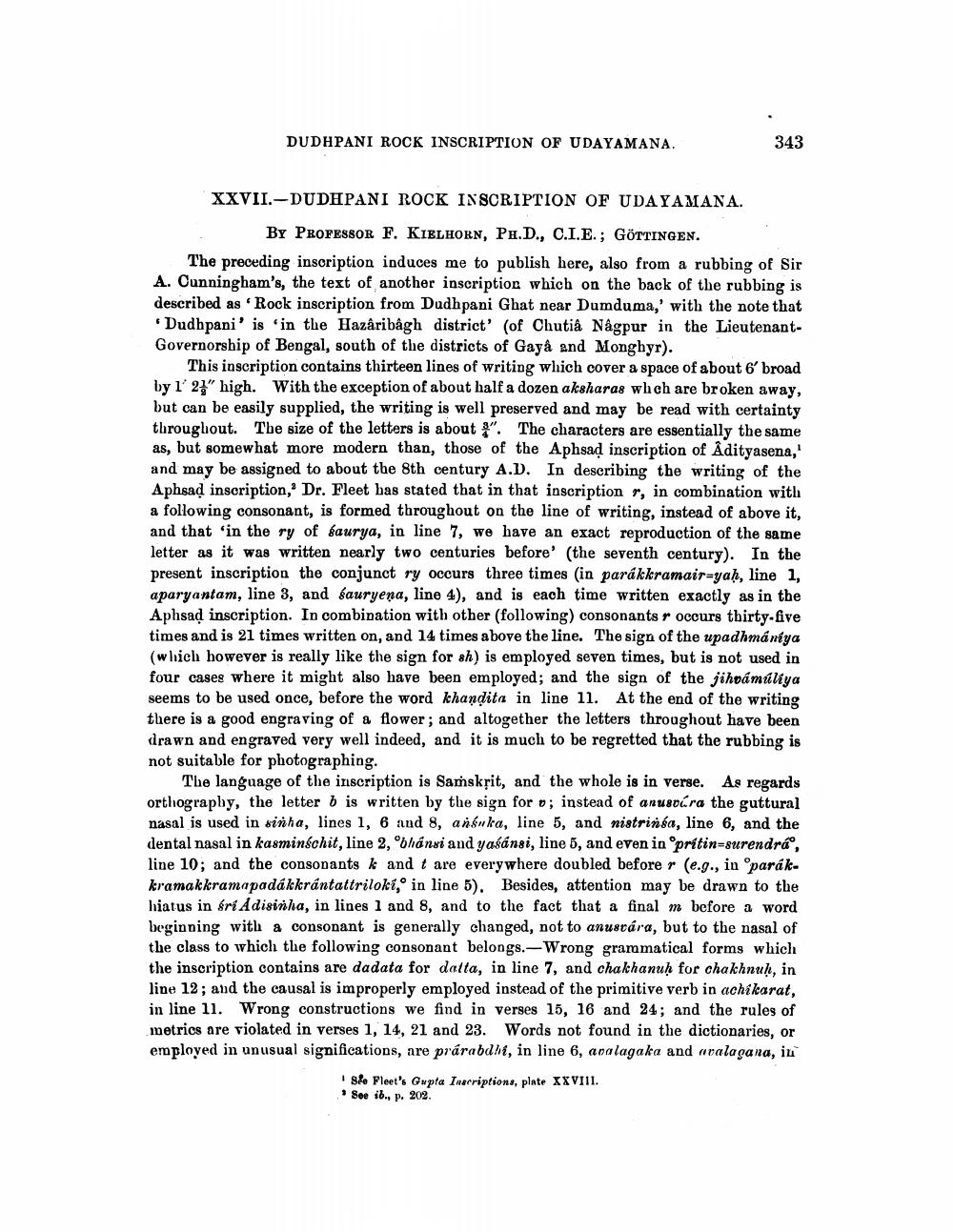________________
DUDHPANI ROCK INSCRIPTION OF UDAYAMANA.
343
XXVII.-DUDHPANI ROCK INSCRIPTION OF UDAYAMANA.
BY PROFESSOR F. KIELHORN, PH.D., C.I.E.; GÖTTINGEN. The preceding inscription induces me to publish here, also from a rubbing of Sir A. Cunningham's, the text of another inscription which on the back of the rubbing is described as 'Rock inscription from Dudhpani Ghat near Dumduma,' with the note that . Dudhpani' is 'in the Hazaribagh district' (of Chutia Nagpur in the LieutenantGovernorship of Bengal, south of the districts of Gaya and Monghyr).
This inscription contains thirteen lines of writing which cover a space of about 6' broad by l' 21" high. With the exception of about half a dozen aksharas whch are broken away, but can be easily supplied, the writing is well preserved and may be read with certainty throughout. The size of the letters is about". The characters are essentially the same as, but somewhat more modern than, those of the Aphsad inscription of Adityasena, and may be assigned to about the 8th century A.D. In describing the writing of the Aphsad inscription, Dr. Fleet has stated that in that inscription r, in combination with a following consonant, is formed throughout on the line of writing, instead of above it, and that in the ry of saurya, in line 7, we have an exact reproduction of the same letter as it was written nearly two centuries before' (the seventh century). In the present inscription the conjunct ry occurs three times in parákkramair=yaḥ, line 1, aparyantam, line 3, and bauryena, line 4), and is each time written exactly as in the Aphsad inscription. In combination with other (following) consonants r occurs thirty-five times and is 21 times written on, and 14 times above the line. The sign of the upadhma niya (which however is really like the sign for sh) is employed seven times, but is not used in four cases where it might also have been employed; and the sign of the jihvámúliya seems to be used once, before the word khandita in line 11. At the end of the writing there is a good engraving of a flower; and altogether the letters throughout have been drawn and engraved very well indeed, and it is much to be regretted that the rubbing is not suitable for photographing.
The language of the inscription is Samskrit, and the whole is in verse. As regards orthography, the letter b is written by the sign for v; instead of anusvira the guttural nasal is used in sinha, lines 1, 6 and 8, anenka, line 5, and nistrinéa, line 6, and the dental nasal in kasminschit, line 2, Chansi and yaśánsi, line 5, and even in oprítin=surendrá, line 10; and the consonants k and t are everywhere doubled before r (e.g., in parákkramakkramapadá kkrántattriloki, in line 5). Besides, attention may be drawn to the hiatus in fri Adisinha, in lines 1 and 8, and to the fact that a final m before a word beginning with a consonant is generally changed, not to anustára, but to the nasal of the class to which the following consonant belongs.- Wrong grammatical forms which the inscription contains are dadata for datta, in line 7, and chakhanuh for chakhnuh, in line 12; and the causal is improperly employed instead of the primitive verb in achikarat, in line 11. Wrong constructions we find in verses 15, 16 and 24; and the rules of metrics are violated in verses 1, 14, 21 and 23. Words not found in the dictionaries, or employed in unusual significations, are prárabdhi, in line 6, analagaka and wala gana, in
88 Fleet's Gupta Inarriptions, plate XXVIII. Soe ib. p. 202.




